Intel Performance Midrange
In recent months we have said in CPU recommendations that Intel and AMD enjoyed parity in the price ranges and processor speeds where they competed. Of course, AMD did not compete at the top speeds. We normally added that Intel still enjoyed a significant overclocking advantage if that was an important feature for you.
Things were shaken up quite a bit with the introduction of the new Intel Core i7 Socket 1366 CPU. Phenom did not compete nearly as well against the Core i7, but Phenom II is now leveling that playing field - in the upper midrange to low high-end where Phenom II now has competing speeds. In addition, the Phenom II 45nm finally removes the last real impediment to choosing AMD in this price range as it overclocks very well indeed and gives Intel a run for the money - clock for clock.
That makes choosing between the Intel Core i7 system below or the AMD Phenom II system on the next page a more difficult decision than it has been in quite a while. Both systems contain parts that have been chosen for their excellent overclocking abilities, and both motherboards can deliver the 3.8GHz+ overclocks that Core i7 and Phenom II are capable of reaching.
| Intel Performance Midrange PC | ||
| Hardware | Component | Price |
| Processor | Intel i7 920 Nehalem Socket 1366 (2.66GHzx4 4x256KB L2, 8MB L3 Cache) | $295 |
| Cooling | Vigor Monsoon III LT for Socket 1366 | $60 |
| Video | EVGA 01G-P3-1282-AR GeForce GTX 280 SuperClocked Edition 1GB | $320 |
| Motherboard | GIGABYTE GA-EX58-UD3R LGA 1366 Intel X58 ATX | $185 |
| Memory | G.SKILL 6GB (3 x 2GB) DDR3-1333 (PC3 10666) Triple Channel Kit | $145 |
| Hard Drive | Seagate Barracuda 7200.11 ST31000333AS 1TB | $110 |
| Optical Drive | LG BD/HD DVD / 16x DVD+/- RW GGC-H20LK | $99 |
| Audio | ASUS Xonar DX 7.1 | $90 |
| Case | Antec Nine Hundred Black Steel ATX Mid Tower | $100 |
| Power Supply | SILVERSTONE ST70F 700W SLI Ready CrossFire Ready 80 PLUS Certified Modular Active PFC | $100 |
| Display | ASUS VW246H Black 24" 2ms(GTG) HDMI Widescreen LCD Monitor (1920x1080) | $290 |
| Speakers | Logitech G51 155 watts RMS 5.1 Surround Sound Speakers - Retail | $90 |
| Input | Microsoft CA9-00001 Black PS/2 Standard Keyboard and Optical USB/PS2 Mouse - OEM | $16 |
| Operating System | Microsoft Vista Home Premium OEM | $99 |
| Bottom Line | $1999 | |
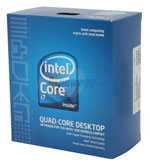 |
The i7 920 is the lowest priced Intel Core i7 you can currently buy - the other two choices are in the $600 to $1000 price range. Don't assume, however, that the 920 is not a powerful processor. The i7 920 is capable of reaching the performance levels of the top i7 CPUs, because it has also proved to be a dynamite overclocker for those who care about that, and that are also willing to provide decent cooling to the i7 920.
You start with a processor that is 30% faster in some parameters than a Core 2 Quad, and then you find you can also overclock this 2.66GHz CPU to 3.8GHz to 4GHz with careful tweaking and better cooling. As you saw in our Phenom II Launch review, the 920 reached as high as 3.8GHz at stock voltage and 4.0 GHz when overvolted to 1.35V. That is a 50% overclock. You will certainly be very happy with Core i7 base performance, but if you are interested in overclocking you will be ecstatic with this new CPU.
 |
The Gigabyte GA-EX58-UD3R has the distinction of being the lowest priced X58 chipset motherboard you can currently buy. Others will soon join that $200+/- club shortly providing more X58 value choices. You probably also noticed that Gigabyte is trying to get as much mileage as possible from their UD3R designation. It seems reasonable to hold on to a good name as much as possible. AnandTech is in the process of testing this value Gigabyte board, and more info will come your way soon. Early user reports are very favorable, including great reports on overclocking. That was enough positive news to choose this Gigabyte for the Performance Midrange Intel System.
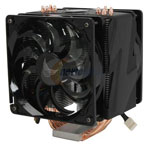 |
Several well-known coolers offer optional adapters for the Intel Socket 1366, but the cooler choice to mate with the Gigabyte X58 board is the Vigor Monsoon III LT. The last time a Vigor Monsoon was reviewed it was an effective but loud TEC (Thermo Electric Cooling) design. This Monsoon is a standard vertical heat-pipe air cooler, with effective and quiet push-pull cooling. The Monsoon appears a good match to the OC capabilities of the i7 920.
 |
At present, most of the editors at AnandTech prefer the performance of GPU solutions from AMD/ATI these days… that is, except when running Intel Core i7. The X58 chipset/Core i7 works best with an NVIDIA video card and drivers. AMD is aware of the issue and is working to provide improved drivers for the i7 platforms, but for now the choice for i7 system video card is the (deep breath…) EVGA 01G-P3-1282-AR GeForce GTX 280 SuperClocked Edition 1GB. This EVGA card comes factory overclocked to a core clock of 621MHz and an effective memory clock of 2268MHz. This video card really is not the equal in performance of the 4870 X2 used in the AMD Performance Midrange system, but the stability and trouble-free operation makes up for the small performance loss - at least for today.
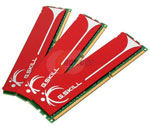 |
The Intel i7 system includes the G.Skill triple-channel DDR3-1333 6GB memory kit. To be blunt, most of the 1333 3x2GB triple-channel kits use the same memory chips, although there are sometimes differences in the SPD chip on the DIMM. We chose the G.Skill on the basis of best price for a 6GB triple-channel DDR3-1333 kit from a known brand. You can select from a number of quality memory suppliers, but make sure to include their warranty and customer service reputation in your decision.
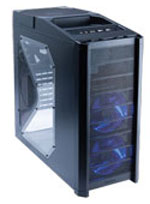 |
The case receives an upgrade with the selection of the well-regarded Antec Nine Hundred that bottom mounts the power supply and provides plenty of internal storage. Cooling is provided by 120mm fans and a massive 200mm top exhaust fan.
 |
The power supply is the well-regarded Silverstone ST70F 700W SLI/CrossFire Ready 80 PLUS Certified modular PSU. The Silverstone 700W has made almost everyone's top performance list for a PSU and it is a good buy at its regular selling price. At the current selling price of $100, it is an outstanding value. The Silverstone is a modular power supply with the flexibility offered by custom cable selection and arrangement.
 |
The ASUS Xonar DX 7.1 is one of the top-performing audio cards on the market today. It is a great upgrade to the onboard sound if you want better sound quality. Game compatibility is excellent, but most game creators assume everyone has a Creative Labs sound card.
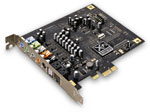 |
If your main reason for having a powerful i7 computer is gaming, you may prefer the Creative 7.1 Sound Blaster X-FI Titanium at the same price that we used in the AMD Performance Midrange system. In our opinion the sound quality is better on the ASUS or an HT sound card, but game compatibility will never be a question with a Creative Labs sound card.
 |
The speakers have been upgraded to the Logitech G51 155 watts RMS 5.1 surround sound speakers. They are selling for $90 after a $40 rebate, which is a great value on these well-regarded powered speakers.
 |
The LCD display resolution is the same 1080p HD resolution chosen for the Value Midrange systems. The size of the monitor increased to 24" so everything on screen is just a little larger. The ASUS VW246H 24" provides the preferred HDMI input, as well as DVI and an analog VGA port. Panel speed is rated at an incredible 2ms, but we have found most current LCD panels perform similarly and the speed rating does not really guarantee very much. The ASUS monitor provides a sharp image, good colors, and fast panel speed at a very good price of $290. For more information on what matters in a monitor and how to read LCD specifications, take a look at our Holiday 2008 Display Guide.
The remaining components are the same as our Value Midrange systems. The hard drive remains a 1TB Seagate. The optical drive is the LG BD. The Microsoft OEM keyboard and optical mouse provides input, and Vista Home Premium OEM runs the system. For more information on these components, refer to page 3.










77 Comments
View All Comments
7Enigma - Monday, January 12, 2009 - link
I've never heard of this and 20min of searching Anandtech doesn't show it in any CPU cooler roundups that I can find? The Xigmatek AIO or something does show up but clearly this is a different part. Could someone link me to an Anand article that has a review of it?7Enigma - Wednesday, January 14, 2009 - link
Anyone interested see Christof's reply on (now) page 6. Apparently while never written up in an Anand article the cooler was tested in-house and did very well for the $.7Enigma - Wednesday, January 14, 2009 - link
*Mr. Fink was actually the person whom tested the cooler. Edit button, EDIT BUTTON, G-D edit button!7Enigma - Monday, January 12, 2009 - link
$190 E8500$165 E8400
Is there any real benefit to the E8500 over the E8400? I plan on a modest OC, likely not looking to increase the voltage (maybe slightly), is there something I'm missing since the stock frequency seems to be under 200MHz, and the cache size is the same?
Thanks.
Jynx980 - Monday, January 12, 2009 - link
Good guide. I am planning on building a similar system as the Intel Midrange system. I would like to see power draw and acoustic info though. Why are the CPU heatsinks referred to as Rifle coolers?Typo?:the E8600 has been matched with components that are also excellent choices for overclocking.
Jynx980 - Monday, January 12, 2009 - link
I am also curious if CPU and video card prices will get a bit of a shuffle soon with the new Phenom and GTX 295.jasonb - Monday, January 12, 2009 - link
Phenom II is 4x 512 KB, not 4x 512 MB.IHateMyJob2004 - Monday, January 12, 2009 - link
I would love to have someone write up an article (or articles) that revolves around the idea of data storage at home.these days, my concerns are with the following:
1) perosnal finances
2) images (digital cameras are popular these days)
3) videos ($300 for a good digital camcorder)
4) music (all those with iPods step forward)
None of this is processor heavy, but requires alot of disk space. And since alot of important data is on there, backups are also needed.
So, maybe come up with various price points with requirements for backup.
Low end could be simple backup on an external drive.
Mid end could be the same but with more storage
High end could be crazy (raid 0+1?) and include multiple backups.
And some sort of plan for offsite backup (optional) for each build. The high end could use an online service while the low end could just include an extra external hard drive which is kept at another location.
System builds like this do not exist and I want it and I'm sure alot of us ex-gamers (now 30+ year old parents) have much different concerns than the college crowd.
garydale - Monday, January 12, 2009 - link
OK, I can appreciate that a lot of people are looking for game machines, but there are also those of us who are looking for machines to do office work, touch up pictures, and edit home videos. Moreover, if you're not stuck on Windows, you can try other things that can give you a nice performance boost.None of the machines here use what I consider to be all but obligatory nowadays - a RAID array. Of course, using Linux makes setting up a nice 3-disk or 4-disk RAID5 array easy and cheap. And it really boosts your read performance, something even gamers can appreciate. Since HD access is a real bottleneck, going for a RAID array makes sense.
Secondly, how about going to a real 64bit operating system? Even the 64bit Vista usually has you running 32bit programs. With Linux however you get 64bit right the way through without having to worry about driver or program compatibility (I'm running Debian/Lenny on my workstation which, although still in "testing", is far more stable than the antique XP, let alone Vista).
Admittedly, 64bits doesn't always buy you a lot of extra performance, but in the real world, it's a free upgrade. And sometimes it can get you a big payback while it rarely costs you any performance.
Anyway, I consider my system to be midrange but it costs less than the lower cutoff point, with the 3 HDs, quad-core processor and (if I needed a new one) display being the only expensive parts. Since I'm not a gamer, I didn't bother with a video card. The onboard video handles full-screen HD video nicely so why bother? This also allows me to use the wonderfully economical and quiet PC Power & Cooling Silencer 370 power supply.
Another cost savings is to use a KVM switch instead of a monitor. Some people are connecting multiple monitors up to a single computer, so obviously this isn't a general solution, but with Linux providing multiple virtual desktops, I find that a single monitor for multiple machines works well. And certainly a reasonable KVM saves money and desk space over multiple keyboard, mouses and monitors.
7Enigma - Monday, January 12, 2009 - link
Mr. Fink,Can you recommend a good PSU in the 500-550w range? I've been waiting for the 2nd part of the PSU reviews that have that range as I feel the 750w is overkill for my single gpu build. Maybe send Mr. Katzer an email since he did the 350-400 article?